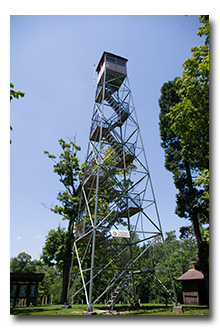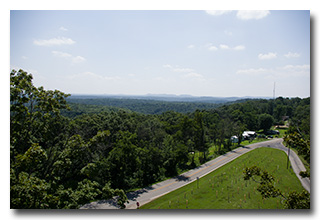
by William Eric McFadden
Support-Your-Parks Summer 2019 RATpedition, Day 1
From the forest's website:
-
Scioto Trail State Forest maintains 26 miles of bridle trails for day use by horseback riders and hikers. Mountain bikes are also permitted on these trails.
Six miles of paved roads and 18 miles of gravel roads provide good access to all areas of the forest. Scenic vistas and overlooks on several of the roads attract many visitors year-round, but especially during the fall when the leaves are turning color.
Populations of deer, wild turkey, squirrel and grouse encourage many hunters to pursue their favorite sport at Scioto Trail. Mushroom hunting in the spring is attracting more and more visitors to the forest each year.
Pictures
- The park sign
- The firetower
- The view from the firetower
- Eric operating; photo by Miles McFadden
- Eric's station
Description
On Saturday, July 20, 2019, on the first day of the two-day Support Your Parks Summer 2019 event, two members of the Southeast Ohio Radio Adventure Team undertook an aggressive operation to activate five POTA units in southern Ohio. Eric McFadden, WD8RIF, and Miles McFadden, KD8KNC, drove over 150 miles and were on the road for eleven hours to visit and activate Great Seal State Park (K-1954), Hopewell Culture National Historical Park (K-0737), Scioto Trail State Forest (K-5448), Scioto Trail State Park (K-1990), and Lake White State Park (K-1971) as part of the Parks on the Air (POTA; link) program.
The third stop was Scioto Trail State Forest, K-5448.
 Eric and Miles arrived at the firetower in Scioto Trail State Forest at about 1730 UTC. After a quick survey of
the area surrounding the base of the firetower, Eric and Miles set up the station in the shade of a stone-and-beam
picnic shelter and some large trees, quickly deploying the 28½' end-fed vertical supported on an MFJ-1910 33'
fiberglass mast and setting up the KX3 on Eric's folding camping chair. Eric was on the air by 1744 UTC.
Eric and Miles arrived at the firetower in Scioto Trail State Forest at about 1730 UTC. After a quick survey of
the area surrounding the base of the firetower, Eric and Miles set up the station in the shade of a stone-and-beam
picnic shelter and some large trees, quickly deploying the 28½' end-fed vertical supported on an MFJ-1910 33'
fiberglass mast and setting up the KX3 on Eric's folding camping chair. Eric was on the air by 1744 UTC.
Eric began operations on 80m for a QSO at 1745 UTC with his friend and fellow SEORAT-member, K8RAT. Not expecting much additional activity on 80m at that time of day, Eric switched to 40m to continue operations.
To test the POTA Spots website, Eric began operations on 40m with several long CQ calls formatted precisely as specified by instructions on the POTA FAQ (link), "CQ POTA WD8RIF WD8RIF K5448 K", sent by the KX3's internal memory keyer at 18wpm.
As soon as the first spot appeared, the QSOs began. Eric's first QSO on 40m came at 1752 UTC with NC4M. Eric's ninth QSO on 40m came at 1804 UTC with KD1CT, just twelve minutes after his first QSO on 40m.
 Switching to 20m, Eric's first QSO there was a park-to-park QSO at 1809 UTC with NA9M, who was activating
White River Marsh State Wildlife Area, K-4341. As at Great Seal State Park and at Hopewell Culture earlier
in the day, QSOs on 20m came briskly. It took Eric just twenty-five minutes to make eleven QSOs on 20m, with
his eleventh QSO on 20m coming at 1836 UTC with W0ITT.
Switching to 20m, Eric's first QSO there was a park-to-park QSO at 1809 UTC with NA9M, who was activating
White River Marsh State Wildlife Area, K-4341. As at Great Seal State Park and at Hopewell Culture earlier
in the day, QSOs on 20m came briskly. It took Eric just twenty-five minutes to make eleven QSOs on 20m, with
his eleventh QSO on 20m coming at 1836 UTC with W0ITT.
While Eric was busy making a QSOs, a couple who had arrived earlier and had spent some time alone in the picnic area, asked Miles to take their picture—they had just gotten engaged there at the park.
After tear-down, Eric and Miles climbed the firetower to enjoy the vista and then made the very, very short drive to the fourth of the five parks, Scioto Trail State Park, K-1990.
Eric's log for this operation contained many callsigns that Eric was to see throughout the day as he completed activations at five locations: K8RAT, N2ESE, WT4U, N4DPM, WA9LEY, KD1CT, KO4SB, W0ZTP, W0ITT, K4CAE, plus others.
All Eric's QSOs were CW and were made at the 5-watt level. Miles didn't operate but helped with set-up and tear-down, photography, spotting, and navigation.
(return)